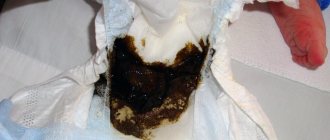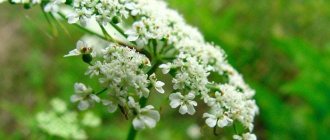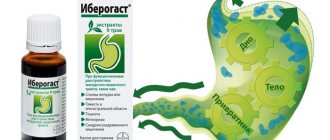Throughout the first month after the baby is born, parents and loved ones are primarily concerned with how much the newborn ate, how he wore diapers, and how well he slept. Since the baby’s digestive system is very far from perfect and is in its infancy, certain difficulties often arise with the gastrointestinal tract. To deal with regurgitation, gas, constipation, or greenish stool in your baby, it is important to understand what your baby's digestive system is like.
Parents of babies often worry about the color of their children's stool.
Features of the gastrointestinal tract in newborns
During the first few months, the main task of a newborn baby's body is to digest breast milk and absorb all the nutrients it contains. A baby's stomach is very small at birth, but grows very quickly. If on the first day of life the baby is able to drink no more than 10 ml of milk, then by the 10th day he will calmly drink 70-80 ml.
Despite the fact that by the time of birth an infant has an already formed esophagus, it is short. At the same time, the sphincter, which should restrain food entering the stomach, still works weakly. As a result, all excess milk is safely regurgitated by the baby.
The structure of the internal organs of a newborn differs from that of adults. For example, the length of its intestines in relation to the length of its body is much greater. If the length of a child’s small intestine is approximately a meter, then in adults a similar organ has a length of no more than 10 cm. This is due to the need for the baby to adapt to lactotrophic nutrition.
Interesting. The mechanism of functioning of the digestive system starts in a newborn after the first attachment to the breast.
Normal stool in a baby
Diarrhea and fever in a child
The color and consistency of a child's stool from the first day until he is one year old constantly undergoes changes. This is due to changes made periodically to his diet. A big role is played by what kind of feeding is practiced for feeding: breast, artificial or mixed type. When complementary foods are introduced, the appearance and density of feces also change.
Green stool is not always a sign of pathology
In the first few days after birth, the baby's stool is very unusual. They are dark in color, thick, viscous and odorless. Around the third day, stool begins to gradually change its consistency and becomes more liquid. The color also changes - it acquires a greenish tint, which often frightens inexperienced mothers. At this stage, the appearance of green poop in a child is the norm. Moreover, within a week the color of the stool will acquire a more familiar yellowish tint. Before the introduction of complementary foods, normal baby stools are yellow and have a sour odor.
Important! If a month-old baby has problems with feces, this information must be brought to the attention of the pediatrician. It is possible that some problems in the functioning of the intestines will be identified.
Causes of green stool in a child
- In the first days of life, meconium is released from the baby's body - greenish-colored stool. The coloring is due to the ingestion of blood during passage through the birth canal, as well as the fact that the liver and other internal organs have not yet adapted to extrauterine life.
- If the newborn has anatomical jaundice, the stool becomes green as a result of increased release of bilirubin.
- In the first weeks of life, a baby's stool is more susceptible to oxidation, so a green color may appear after a bowel movement has occurred. In this case, the child does not show any anxiety, and the process of bowel movement is not accompanied by pain or other troubles.
- Dysbacteriosis. The disease occurs due to improper introduction of complementary foods and further nutrition, lack of nutrients, early weaning of children under 1 year old, and unstable nervous condition. This diagnosis is supported by bloating, flatulence, pain in the abdomen, and the appearance of allergic rashes on the skin.
- Sticky, dark green stool, similar in color to swamp mud, is a symptom of salmonellosis. The disease is caused by pathogenic bacteria that enter the child’s body through products of animal origin - meat, eggs, milk. The pathology is accompanied not only by stool of a specific color, but also by frequent bouts of vomiting and an increase in body temperature to 38-39 degrees. A child over 3-5 years old can already talk about his feelings: abdominal pain and nausea. Younger children in most cases cry loudly and pull their legs towards their tummy, striving for the fetal position.
- Stool with green mucus and bloody discharge accompanies dysentery.
As you can see, the degree of danger of the listed pathologies and diseases is very different, so parents must sensibly assess the situation and understand when the problem can be dealt with on their own, and when urgent medical help is needed.
Causes of stool color change
Loose stools in a breastfed baby
All the reasons why a baby’s stool color changes can be divided into two large groups: physiological and pathological.
Green baby chair can have different shades
Physiological reasons
A breastfed baby, whether one month old or three months old, has a normal stool color of golden yellow. This is due to the presence of bilirubin in breast milk, which is responsible for the bile pigment. In artificially produced children, the color of feces, like in adults, can have various shades of brown. With the introduction of complementary foods, the color of stool can change in the most unexpected way and be:
- light brown (with a predominantly plant diet);
- dark (with an abundance of meat products in the diet);
- greenish (when feeding a lot of green vegetables);
- red (when eating beets or red grapes);
- black (when currants or blueberries appear in the diet);
- orange (when eating carrots or pumpkin).
Pathological causes
In some cases, changes in the color of stool may be pathological. For example, white stools may be associated not only with dietary errors (for example, abuse of cottage cheese or sour cream). The reason for the change in shade may be due to stagnation of bile, rotavirus, influenza, or even pancreatitis.
Dark stool is sometimes a symptom of bleeding in the digestive system. The most common cause of darkening of the stool is the introduction into the diet of mixtures or foods containing large amounts of iron.
Reasons for “greening” of baby’s stool
Why does my baby have green stool? The etiology of changes in the shade of stool is very diverse, from natural to pathological:
- nutrition related;
- teething;
- dysbacteriosis;
- allergic reactions, including reactions to milk proteins and lactose;
- intestinal infections;
- ARVI;
- reaction to vaccinations and antibiotic therapy.
The influence of nutrition is worth considering separately. Pathological signs, despite all their diversity, have a common denominator - the child’s restlessness, his regular crying and sleep disturbances .
In some cases, a change in the color of stool is accompanied by an increase in body temperature to febrile levels and impaired respiratory function. In this case, you should immediately consult a doctor.
Dysbacteriosis
Dysbacteriosis or dysbiosis is one of the most common diagnoses in children 2 months of age. In addition to changes in the color of feces, dysbiosis is accompanied by constipation/diarrhea, increased regurgitation, anxiety and sleep disturbances. One of the reasons for the development of dysbiosis in a child is treatment with antibiotics.
Allergy
Allergic reactions are also common. It is associated with errors in the mother’s diet during breastfeeding and the body’s hyperreaction to the components of the mixture substance during artificial feeding. It manifests itself as green diarrhea, anxiety, in some cases low-grade fever, and skin symptoms - peeling, pustular rashes, eczema.
Lactase deficiency
Lactase deficiency is a hereditary disease, the symptomatic manifestations of which are green diarrhea, restlessness of the baby and skin manifestations (milk scab, eczematous rashes, etc.).
Intestinal infections
Intestinal infections are very dangerous, especially for a baby of this age. If you have diarrhea and a sharp increase in bowel movements, foamy stools that are green or black mixed with blood, or an increase in body temperature, you should immediately consult a specialist.
Colds, vaccinations, teeth
Respiratory infections, teething, and vaccinations may be accompanied by intestinal disorders and “greening” of the stool. There is nothing dangerous about this, and over time the symptoms go away without medical intervention.
Important! If the color of the stool changes, the child becomes restless or has an increase in body temperature, you should immediately consult a doctor. At this age, infectious diseases can be very dangerous.
Breast milk and its effect on stool color
If the baby is breastfed, the color and quality of his feces depends on:
- food eaten by mother;
- the quality of the milk and what proportion of the milk the baby sucks (the less fatty part is closer, the baby gets fatty milk by sucking the breast to the end).
Important! The color of the baby's stool is influenced by the color of the foods eaten by the mother. Vegetables and fruits (lettuce, greens, apples, broccoli, spinach, etc.) that have a greenish color will give the feces a dark green and sometimes quite bright color. This is fine.
If the baby is lazy and does not suck the breast completely, he receives a product depleted in fat. This makes his stool looser and gives it a greenish color. It is the fats that make poop brown.
A green tint and runny feces are not dangerous, but it is better to teach the baby to suckle from one breast at one feeding (with sufficient lactation).
The mixture and its effect on the color of stool
With artificial feeding, the stool usually changes color when moving from one formula to another.
Stools may be light green if there is a high iron content in the mixture. If the mother is concerned about the color of the stool, you can change the mixture for the baby and look at the result. You just need to do it correctly, gradually transferring the baby to a different diet over the course of 1-2 weeks.
What does the color of stool indicate?
Vomiting, diarrhea and fever in a child
Most of all, parents are afraid of green feces in their children. As in previous cases, the reasons for such a dramatic change in color vary. Therefore, before you panic, you should figure out why your child might have green stool.
Even older children may have green stool.
Greenish tint
Greenish-colored feces in a child are most often associated with the specifics of nutrition. Mostly parents of bottle-fed infants face this problem. Mixtures with a high iron content give a greenish tint to feces. Sometimes slight greening of the stool is associated with the transfer of the baby to artificial nutrition with an unusual composition for him. If the color change occurred immediately after replacing the mixture and did not recur, there is no cause for concern. Both a two-month baby and a one-year-old toddler most often react to any dietary changes by changing the color of feces or their consistency.
Another greenish tint to the stool can be associated with excess sugar in the mother’s food, early onset of complementary feeding (from 4-5 months), improper absorption of breast milk and digestive problems (both for the child and his mother).
Green color
The rich green color of feces in some cases indicates certain diseases of the gastrointestinal tract. In parallel with the change in the color of the stool, the child may have a stomach ache and an increase in body temperature. Thus, green poop in a child is sometimes one of the symptoms of dysbiosis.
A small child's stool sometimes becomes green after taking antibiotics. This is directly related to the death of leukocytes and their accumulation in the intestines.
Often accompanied by green stool and dysentery. Its other symptoms are profuse vomiting, nausea, abdominal pain, fever, weakness and body aches.
Dark green color
Dark green stool in a newborn is normal. The most important thing is to make sure that there is no unpleasant odor. If it is present, and there are other frightening symptoms, you should worry and figure out the cause of the problem.
If the stool is of normal color, but there is dark green mucus in it, this may be normal, but it may also be a sign of the development of dysbiosis. In the latter case, the child will be capricious, and his appetite will not be the best.
Many modern pediatricians, including Dr. Komarovsky, do not consider dysbiosis in infants to be a pathology. Accordingly, treatment is not prescribed to the baby in most cases. The food system of a small child adapts to new conditions, and many disruptions in its functioning are normal. Immediately after the birth of a newborn, his stomach is populated with microflora. During this process, not only may the child have dark green stools, but also their liquefaction.
Why does breastfeeding baby have green stool?
If green poop in your baby does not allow you to sleep peacefully, you can search and analyze the reasons for the appearance of green stool. A baby who is completely on breastfeeding does not have many of them.
Many babies experience physiological jaundice immediately after birth. The bilirubin leaving the body turns the baby's stool green. Usually, with proper care, bilirubin is eliminated from the little one’s body within 2-3 weeks. And gradually the chair acquires its usual shade.
A mother's diet while breastfeeding can also affect the green color of her stool. If a nursing mother’s diet contains mainly plant foods (cucumbers, cabbage, broccoli), is it any wonder that green spots appear in the baby’s stool? And whether the mother needs to reconsider her menu if the baby is cheerful and cheerful is a completely rhetorical question.
But do not forget that green poop sometimes signals an allergic reaction to some product. This nuisance is usually accompanied by restlessness, redness and rashes on the cheeks and butt. These are all signs of a food allergy.
There is another interesting opinion that stool with green spots and lumps appears if the child does not suck hind milk well, which is fattier and more nutritious. That is . the balance of consumption of fatty and non-fatty foods is disrupted. For a baby, such milk is something like a hearty lunch, while foremilk is less fatty and serves as a drink. Therefore, if for some reason a child eats only foremilk, the stool becomes green.
Reasons for greening from 2 months to a year
To understand whether there is cause for concern if the child’s stool turns green, you should trace the cause-and-effect relationships from two months to one year:
- 2 months – a possible cause of green stool is dysbiosis due to an unstable intestinal condition;
- 3 months – due to slow development, green baby stool is normal;
- 4 months – the cause of a change in the color of stool is often untimely complementary feeding;
- 5 month – greenish tint depends on the introduction of additional nutrition;
- 6-7 months is the age when a child begins to put foreign objects in his mouth and bite, therefore a green tint to the stool can be associated with infections and intestinal disorders;
- 8-10 months – green color may be associated with the composition of complementary foods or intestinal disorders;
- 11-12 months – a greenish tint to the stool is an indicator of the foods used in food or a marker of an allergic reaction.
Causes of green stool
Eating habits
Eating large amounts of green leafy crops (spinach, dill) and vegetables leads to characteristic changes in the color of stool due to excess content of the chlorophyll pigment. At the same time, the feces are formed, do not have a putrefactive odor, and the frequency of bowel movements does not change. The dark greenish color of stool is caused by the consumption of black licorice, caramel and marmalade with dyes. The color of the stool returns to normal after 2-3 days.
Dysbacteriosis
The accumulation of pathogenic microorganisms in the intestines provokes rotting processes, and the formation of specific protein compounds occurs, which cause the discharge of green feces, which have a strong foul odor. Fecal masses with dysbacteriosis are unformed, soft, sometimes liquid. The color ranges from greenish-yellow to dark green. Sometimes a light green coating forms on the surface of the stool.
The passage of stool of an atypical greenish color is combined with discomfort and rumbling in the abdomen, flatulence, pain and cramps. During defecation, patients note severe pain along the intestine, especially in the left sections. The changed color of feces persists for a long time, until the cause of dysbacteriosis is eliminated. Such a clinical picture is an indication to visit a doctor.
Intestinal infections
The entry of pathogenic microorganisms into the intestines and their reproduction are the main reasons for the appearance of green stool in adults and children. The symptom is pathognomonic for salmonellosis. This intestinal infection is characterized by liquid, foamy stools of a dark green color and heterogeneous consistency. Feces have a strong putrid odor, the frequency of bowel movements increases from 5 to 15 times a day, which depends on the severity of the disorder.
The greenish color of stool is also typical for viral infections - rotavirus enteritis, enterovirus gastroenteritis. First, green diarrhea is observed, then the stool loses its fecal consistency - in the case of severe intestinal damage, a greenish liquid with an unpleasant odor may be released during bowel movements. The symptoms are accompanied by nausea, vomiting, diffuse abdominal pain, and lack of appetite.
Chronic gastrointestinal diseases
Changes in the color of stool most often occur with chronic enteritis, which is characterized by deterioration of cavity digestion, fermentation and rotting of food in the intestines. Putrefactive reactions cause the formation of pathological chemical compounds that color stool green. There is diarrhea, feces are copious, foul-smelling, and sometimes take on an “oily” appearance. The main reasons for the discharge of green feces:
- Stomach diseases
: hyperacid gastritis, peptic ulcer, functional dyspepsia. - Intestinal inflammation
: ulcerative colitis, enterocolitis, Crohn's disease.
Allergy
For people prone to allergic reactions, the development of dyspeptic symptoms after eating exotic dishes and allergenic foods is pathognomonic. With a food allergy, diarrhea begins, the rhythm of bile secretion into the intestines is disrupted, which causes the presence of a greenish color in the stool. The duration of unpleasant symptoms is 3-5 days, after which the condition improves and the color of stool returns to normal.
Damage to the hepatobiliary system
The usual brown color of stool is due to the presence of bile pigments, which undergo chemical transformations in the intestines. If the color of the stool changes to green, and heaviness and dull pain appear in the right hypochondrium, it means that the change in color was caused by reasons from the gallbladder and liver. Usually the stool is soft, unformed, light green or yellowish in color.
As the disease worsens, the color of the stool changes to grayish-white. The person is also worried about constant nausea and periodic vomiting with bile impurities. The duration of the change in stool color ranges from several days with biliary dyskinesia to several weeks and even months with cholecystitis and cholangitis. With hepatitis, there are greenish stools, but lightening of the stool is more typical.
Celiac disease
Symptoms are often detected in childhood. Prolonged diarrhea occurs for no apparent reason. Due to disturbances in the digestion of food in the small intestine, stool becomes green, stools are liquid, copious, and foul-smelling. Patients with celiac disease complain of constant abdominal pain, weight loss, and sometimes vomiting. Diarrhea may give way to constipation, when the stool becomes dark, almost black. The patient's condition is progressively worsening.
Complications of pharmacotherapy
There are a number of medications that can change the color of stool. Most often, the symptom appears when treating anemia with iron supplements. The microelement is excreted in feces, which is characterized by a dark green or black color. The symptom persists throughout the period of iron intake. Green feces in adults are also caused by other medicinal reasons: treatment with laxatives, iodine preparations, multivitamin complexes.
Rare causes
- Chronic bleeding from the gastrointestinal tract
. - Tumors of the stomach and intestines
. - Congenital pathologies
: disaccharidase deficiency, intestinal form of cystic fibrosis. - Endocrine diseases
: diabetes mellitus, thyrotoxicosis, Itsenko-Cushing's disease.
1 - Meconium. 2 - Feces for nutritional dyspepsia. 3 - Feces of a baby fed cow's milk
Dangerous symptoms
Parents are strongly advised to begin taking immediate measures if the appearance of green stool in the baby is prolonged and accompanied by the following alarming symptoms:
- moodiness;
- drowsiness;
- decreased mobility;
- foamy stool consistency;
- putrid odor coming from the mouth;
- having too many bowel movements in one day;
- colic;
- skin rashes;
- frequent belching.
In order not to worry about your child’s green stool, adequate preventive measures should be taken:
- Feed your baby regularly, carefully listening to the body’s possible reactions.
- Completely avoid exotic foods and any additives of artificial origin.
- Any treatment of intestinal disorders should be carried out under supervision and as prescribed by a doctor.
- Before offering complementary foods to your baby, carefully study its composition.
- Start using additional nutrition no earlier than the due date (6-7 months).
In most cases, there is no need to worry about the color of your stool.
Compliance with the rules and diet of infants will allow you not to worry about the abnormal color of stool and will allow the baby to feel healthy.
What should parents do?
- If the stool has changed after treatment with antibiotics, everything will be restored after discontinuation.
- When the mother does not follow a diet, the baby may have problems with the gastrointestinal tract; it is necessary to exclude foods that cause discoloration of feces.
- If the baby is on IV, you need to carefully consider the choice of formula. Doctors recommend choosing a mixture with a low iron content.
If the color of a newborn’s stool worries parents, the best option is to consult an experienced pediatrician.
Green stool in a child always causes great anxiety in mothers. However, believe it or not, green stool in a child, especially a very young one, is absolutely normal. And it does not indicate any serious health problem. Familiarizing yourself with information about where green stool comes from in babies will prevent you from panicking. And it will help you quickly take control of the situation.
Being a parent is not only about experiencing happy moments, but also a lot of worries and worries related to the baby’s health, for example, your child suddenly has green stool. Green feces and isolated cases of green stool in your baby may have several causes. Let's look into the issue.











